Propain Hugene 3 CF
Wheel Size: 29’’
Travel:
- Frame: 130 mm
- Fork: 140 mm
Geometry Highlights:
- Sizes Offered: Small, Medium, Large, XL
- Headtube Angle: 64.8°
- Seat Tube Angle: 77.5° (effective)
- Reach: 483 mm (size Large)
- Bottom Bracket Drop: 36 mm
- Chainstay Length: 445 mm
Frame Material: Carbon Fiber
Price: Complete Bikes $3,999 to $6,499
Blister’s Measured Weight (Size Large, custom build): 32.1 lb / 14.6 kg
Test Location: Washington
Reviewers:
- Zack Henderson: 6’, 165 lbs / 183 cm, 74.8 kg
- David Golay: 6’, 160 lbs / 183 cm, 72.6 kg
Test Duration: 3 months

Intro
We’ve seen a lot of do-it-all Trail / All-Mountain bikes creep up in suspension travel in recent years. To use the Santa Cruz Hightower as an example, what was originally a 135mm-travel bike when it launched about a decade ago is now a 150mm-travel one with a 160 mm fork — numbers that would have qualified as an Enduro bike in the time of the V1 Hightower. That’s just one example, but it reflects the direction many bikes have been trending in over the last couple of years.
So it’s quite notable that the new Propain Hugene has 10 mm less travel at each end than the version it replaces, with 130 mm in back, and a 140mm-travel fork. Propain’s take is that they wanted to make a bike that’s light, agile, and efficient, in contrast to a lot of the more gravity-oriented options out there. But they haven’t just XC-ified the Hugene, either — the new one has (slightly) more aggressive geometry than its predecessor, and the combined package looks pretty interesting. Let’s check it out.
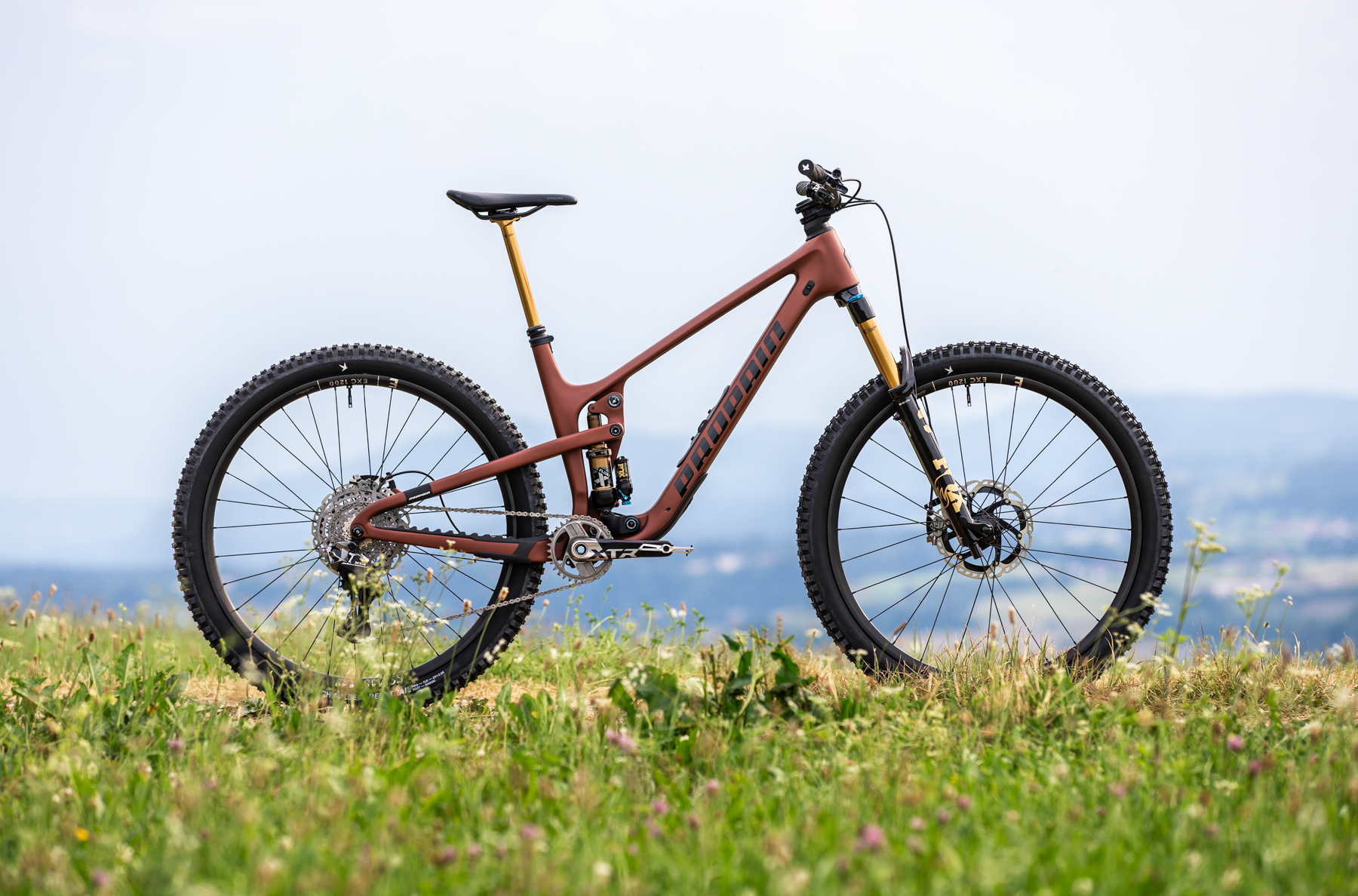
The Frame
There aren’t any huge surprises in the design of the Hugene. Like its predecessor, it’s offered in carbon fiber only and is a dedicated 29er. Propain’s typical Pro10 suspension layout — a dual mini-link arrangement that drives the shock from both ends — is here too, and the vertical shock placement leaves ample room for a water bottle inside the front triangle across the entire size range.

The Hugene’s industrial design hasn’t changed a ton either, though there are some notable updates if you look closer. The seat tube has been widened at the base to allow for more seatpost insertion (Propain says that you can bottom a 200 mm RockShox Reverb AXS to the collar on even the Small frame), and the headtube is now a straight 56 mm affair to leave room for headset cable routing (or an angle or reach adjustment headset, potentially), though, mercifully, there are ports in the downtube so that you can skip that option. And, unlike the outgoing version, the Hugene now features downtube storage via a hatch under the water bottle bosses.
The other frame details are straightforward and sensible: you get a SRAM UDH for Transmission compatibility, lots of rubber protection on the chainstay, seatstay, and downtube, and stainless steel bearings with secondary sealing in all the pivots. The rear brake mount is sized for a 180 mm rotor.
The Hugene also gets a full set of chainguide tabs (which are removable / replaceable), a threaded bottom bracket shell, and strategically placed bolt-on cable guides to keep things rattle-free.
The Hugene gets its 130 mm of rear wheel travel from a 210 x 47.5 mm shock, but kinematic details aren’t specified.
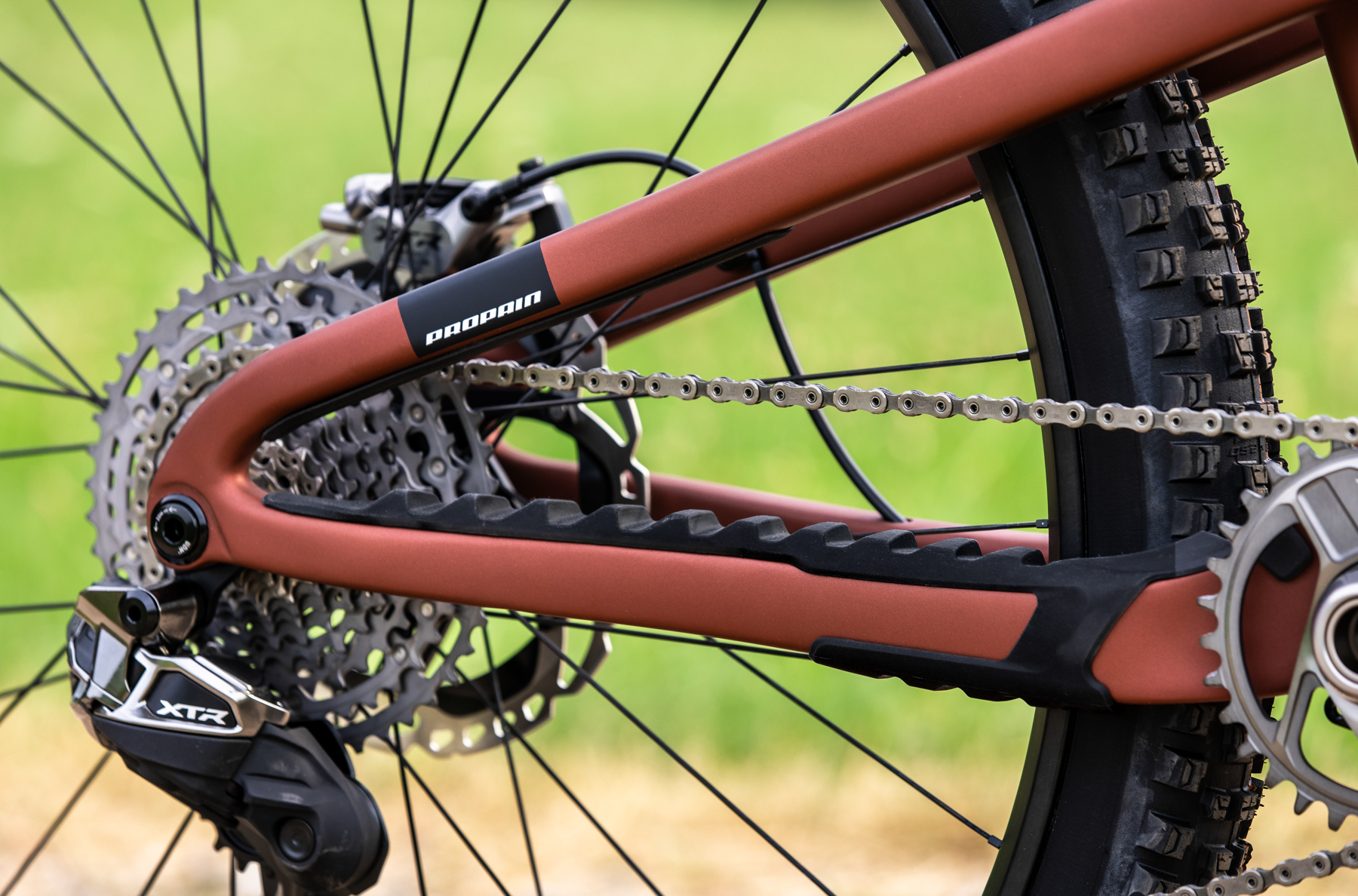
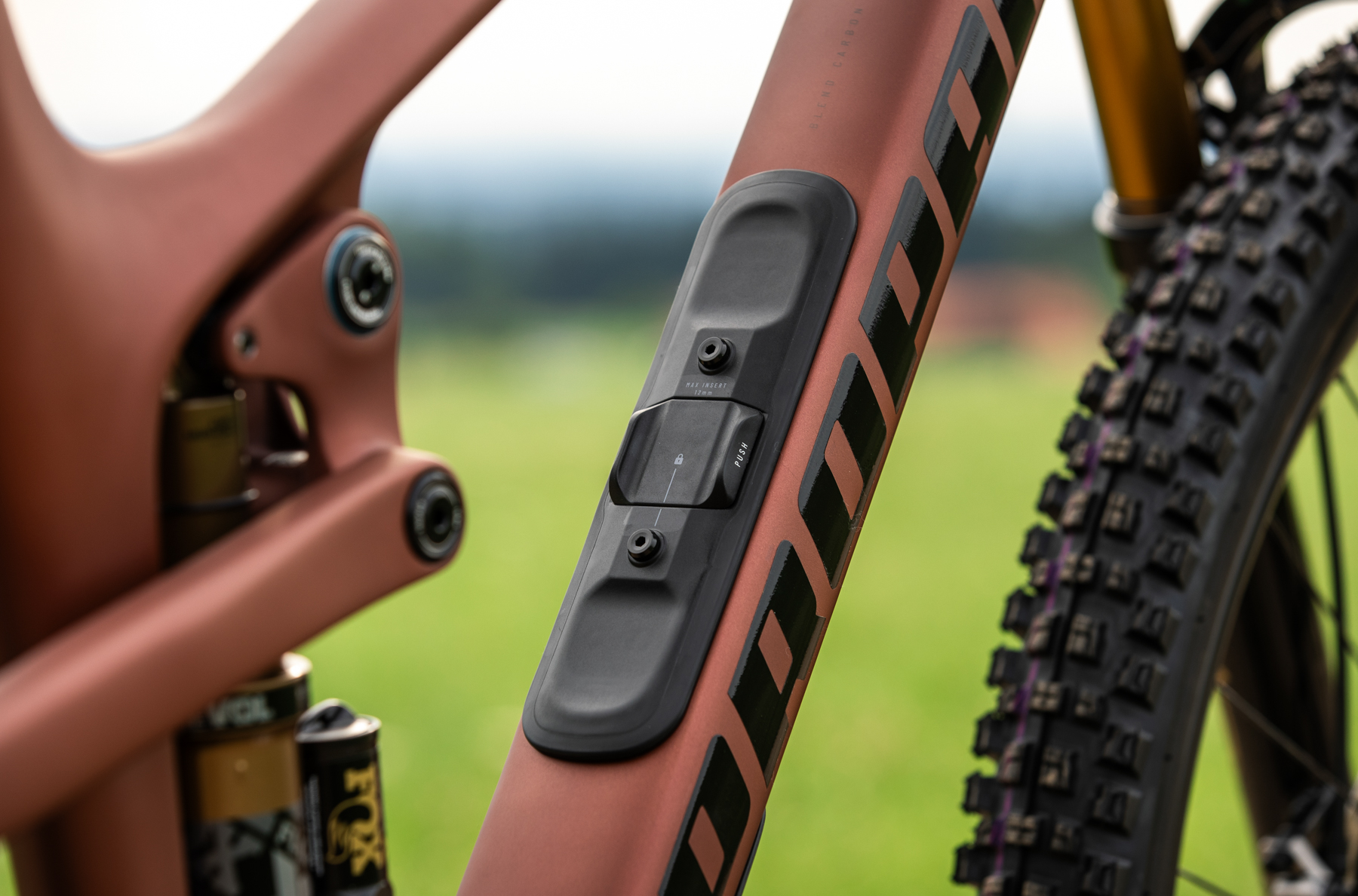
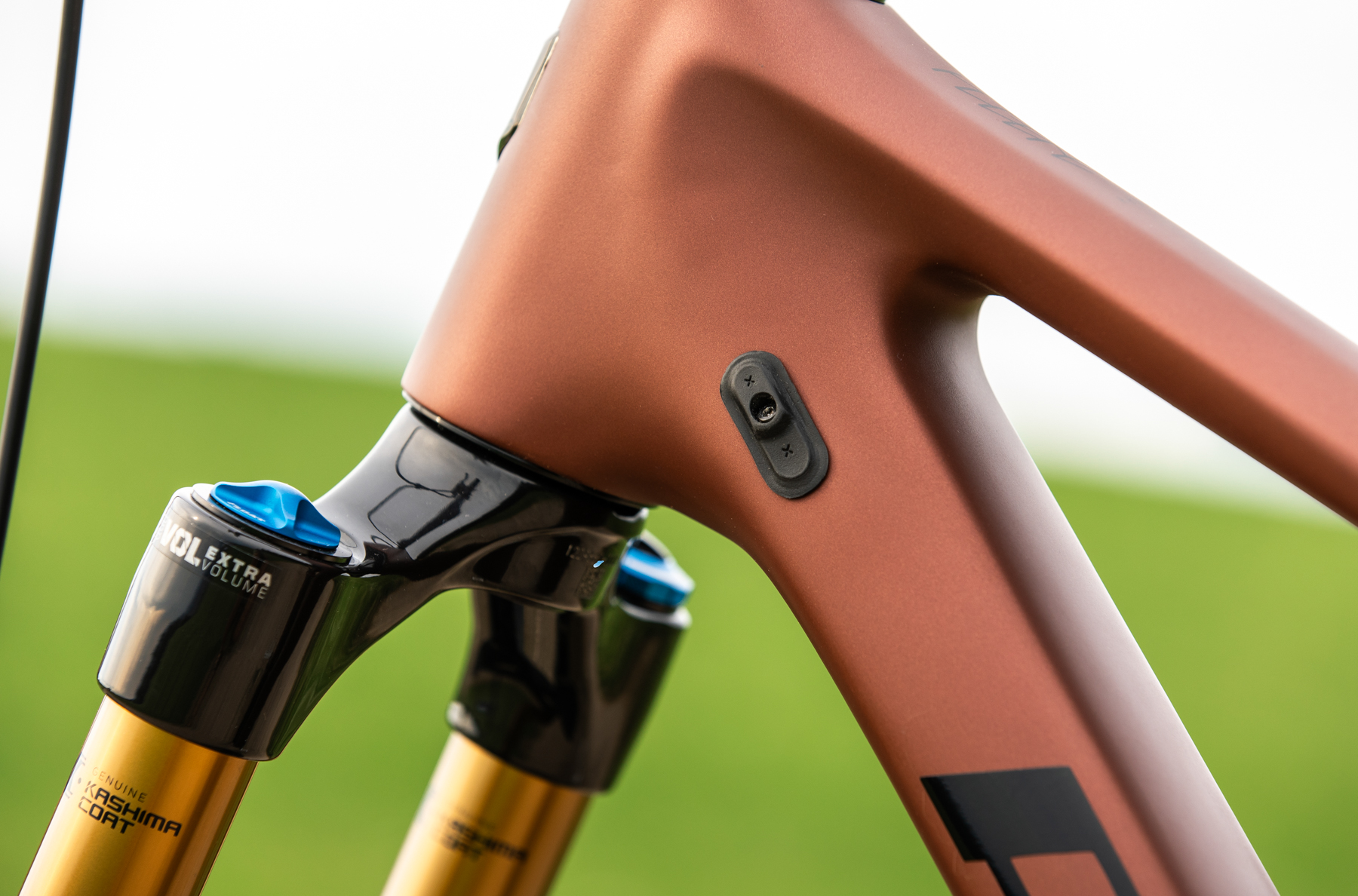
Fit & Geometry
The new Hugene is offered in the same four sizes (Small, Medium, Large, and XL) as the outgoing one, and most of the geometry figures haven’t changed too dramatically, either. The headtube has been relaxed to 64.8°, and the effective seat tube steepened to 77.5° (from 65.5° and 76.5°, respectively); the reach has grown a touch (starting at 433 mm on the Small and growing by 25 mm per size, up to 508 mm on the XL); and the relatively long 445 mm chainstays stick around unchanged.
[The figures for the prior-gen Hugene are with a 140mm-travel fork; the optional 150 mm one slackens it a touch and lops a little off the reach.]
The steeper seat tube on the new bike results in slightly shorter effective top tube measurements for a given size, despite the reach growing slightly, and the bottom bracket drop has been increased by a couple of millimeters (to 36 mm), though that should roughly get canceled out at sag due to the decrease in suspension travel.
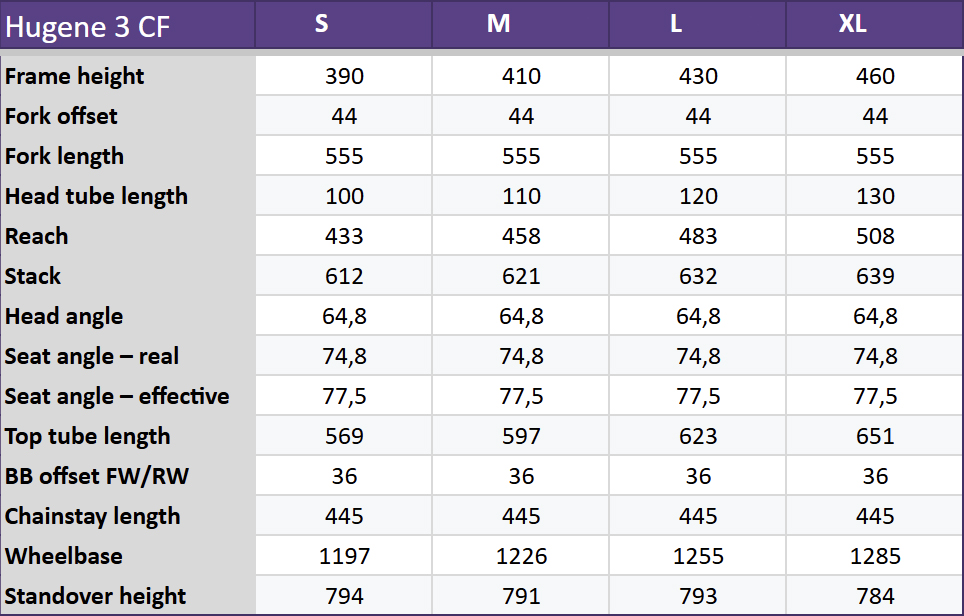
The Builds
Propain offers a number of different builds for the Hugene, which vary by region. The two North American spec options are listed below; for details on the options in your area, check Propain’s website.
Per usual for Propain, the builds on the Hugene are also highly customizable — the base options are just starting points. The configurator on their site lets you put together your own ground-up build if you’re so inclined, tweak one of the standard options, or just run with one of Propain’s suggestions.
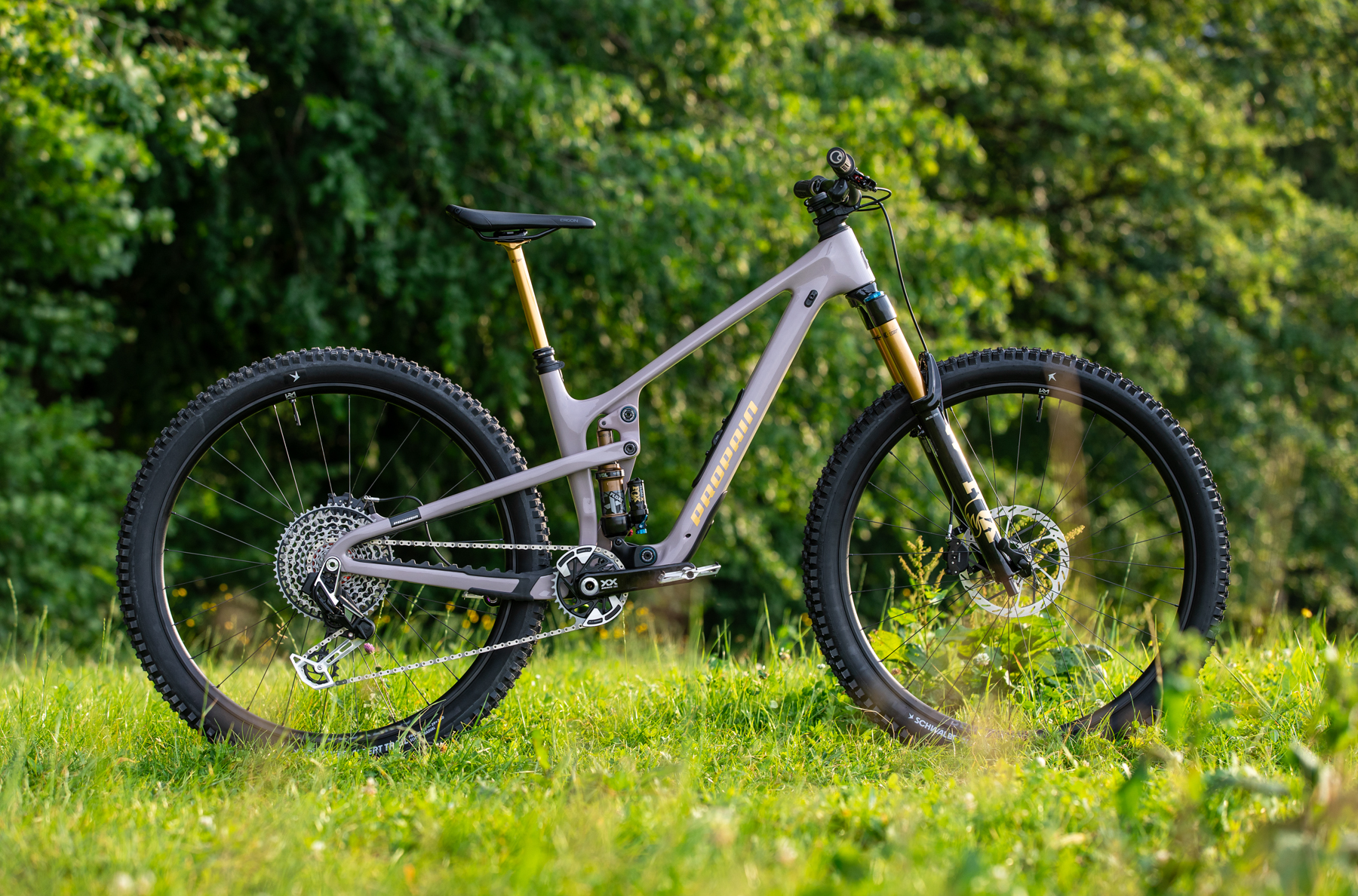
- Drivetrain: SRAM Eagle 70 Transmission
- Brakes: SRAM DB8 w/ 200 mm rotors
- Fork: RockShox Pike Select
- Shock: RockShox Deluxe Select (Linear XL air can)
- Wheels: DT Swiss M1900
- Dropper Post: OneUp V3
- Drivetrain: SRAM Eagle 70 Transmission
- Brakes: SRAM Maven Silver w/ 200 mm rotors
- Fork: RockShox Lyrik Ultimate
- Shock: RockShox Super Deluxe Ultimate (Linear XL air can)
- Wheels: DT Swiss M1900
- Dropper Post: OneUp V3
FULL REVIEW
In a world where bikes tend to grow in travel with each new version, it was surprising to see Propain chop 10 mm off of both the fork and frame travel with the new Hugene 3 CF. This isn’t a case of XC-ifying a Trail bike, though — the Hugene 3 CF proves that geometry, build spec, and suspension feel can come together in surprising ways. Read on for our take on Propain’s latest version of the lone Trail bike in their lineup.

Fit & Sizing
Zack: Having owned the prior generation Hugene 2, I was curious to see how the Hugene 3 would differ. Despite losing some suspension travel, the new Hugene 3 looks a good bit more aggressive in terms of geometry compared to the old one, and those geometry updates yield meaningful differences in terms of fit — and convey some of what to expect from its on-trail performance, too.
The Large Hugene 2 that I owned had a 65.5° head tube angle and 76.5° effective seat tube angle, along with a 480 mm reach, 630 mm stack height, and 445 mm chainstays. The actual seat tube angle was fairly slack at 73.1°, meaning that the 630 mm effective top tube length felt longer than that at higher saddle heights (like mine). Outside of those long-ish chainstays, those numbers were very much in the range of normal for a 140 mm rear / 150 mm front travel bike, but times have changed a bit, and so has the Hugene.
The Hugene 3 has aggressive geometry by short-travel bike standards, with a slack 64.8° head tube angle, 77.5° seat tube angle, and very slightly longer 483 mm reach. Those numbers don’t stray too radically from the original, but it’s also worth noting that the actual seat tube angle got 1.7° steeper — which, combined with the 35 mm rise OneUp bars on our review bike, makes for a shorter, more upright-feeling seated cockpit. It’s comfortable and intuitive, and the Large is definitely still the right size for me, but it’s a more upright fit than I expected from a bike in this travel bracket. I’d go so far as to say that the new Hugene 3 feels a bit more like some longer-travel All Mountain and Enduro bikes that I’ve ridden.
David: I hadn’t ridden any of the prior iterations of the Hugene before hopping on the latest one, but I had a very easy time getting comfortable on it. Like Zack, I found the Large frame to be unquestionably the right size for me (Propain’s sizing chart agrees), and I didn’t second-guess my sizing decision one bit.
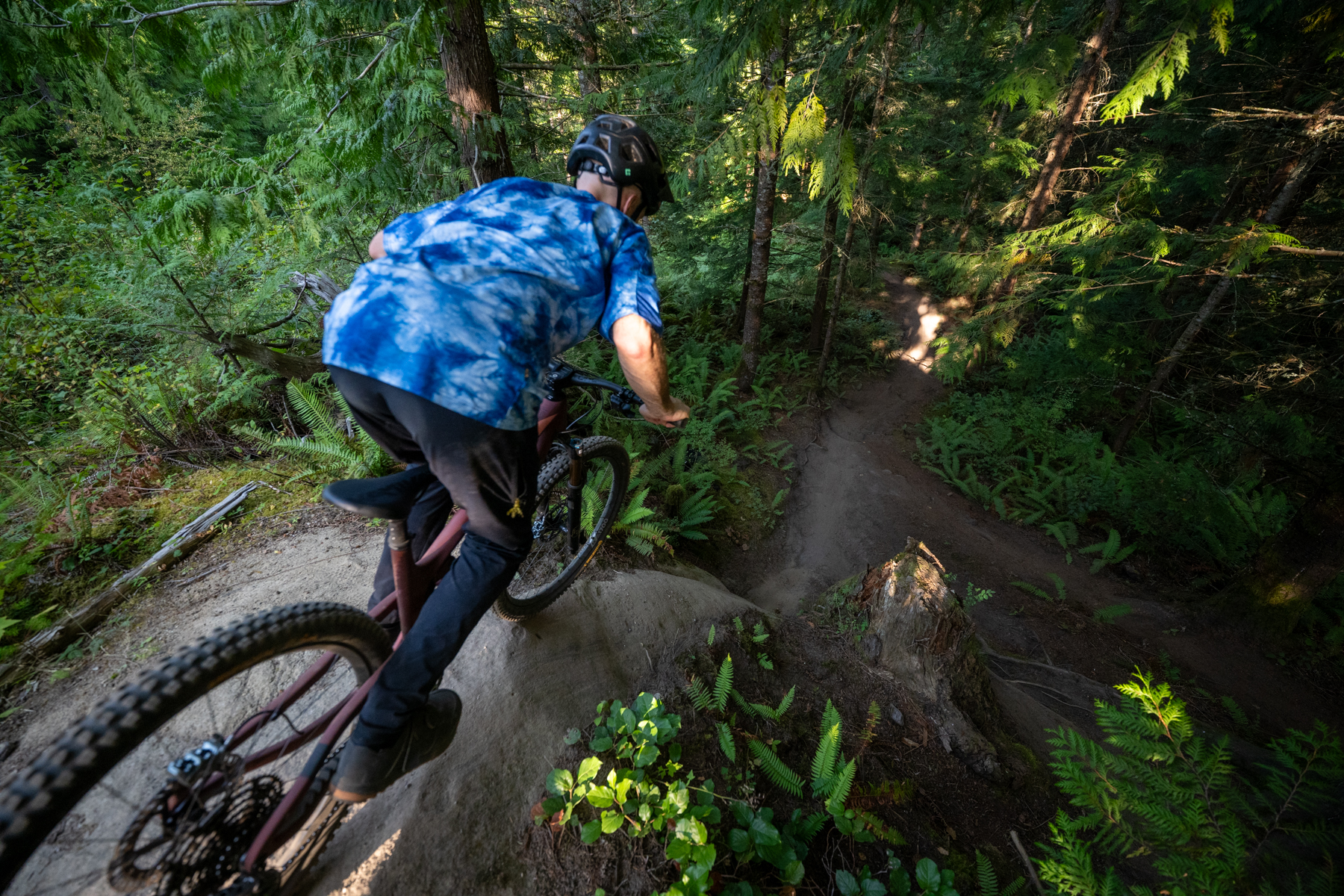
I will also co-sign Zack’s note that the Hugene’s fit and pedaling position feel more reminiscent of an aggressive All-Mountain bike than they do most ~130mm-travel Trail ones. Given what the Hugene does (and doesn’t) do best from a performance standpoint, I think that’s likely a sensible call, but there’s not much about the Hugene 3 that feels like a long-travel XC-derived rig.
Climbing
Zack: That fit carries over into the new Hugene’s climbing performance as well. The slacker head tube angle feels adequately snappy, but the 1,255 mm wheelbase (size Large) is slightly on the longer side for bikes in the 130 mm frame travel range. As such, the Hugene 3 doesn’t feel like the most agile example of a true XC/Trail bike, instead feeling more like what I expect of longer travel bikes.
That doesn’t mean that it’s an inefficient climber, though — overall I’d say the Hugene does a good job of balancing rear-end traction with efficiency. Those 445 mm chainstays seem to help in keeping the front wheel tracking on steeper climbs, while the suspension does a nice job of digging the rear wheel into the terrain. There’s a tiny bit of pedal bob, but I think that’s more down to how sensitive the initial part of the Hugene’s travel is, rather than it having inadequate levels of anti-squat. Especially for only having 130 mm of travel out back, the Hugene 3’s rear suspension feels quite plush and forgiving off the top. That’s a marked departure from the prior Hugene 2, which offered a particularly firm pedaling platform and sharp handling for a bike with 140 mm of rear travel, but had relatively poor small bump compliance.
That said, the Hugene still isn’t the bike I’d choose if climbing efficiency were the top priority. It’s good in that regard, as a 130 mm travel bike should be, but the Hugene feels more like a “sit and spin” example of the category than one that especially rewards aggressive efforts. The Hugene 2 felt markedly more responsive than other bikes in its class when on the gas, and the Hugene 3 backs off of that a bit.
I think much of that comes down to the build, in our case, which is surprisingly burly for a short travel bike. The tough DT EX1700 wheels and Enduro-casing Continental Kryptotal tires (with a Soft compound rear and Super Soft front) lend a damped, grippy feel to the Hugene’s personality, versus prioritizing low rolling resistance and snappy efficiency.
David: Yup. The Hugene’s seated pedaling position feels fairly upright, and the cockpit feels fairly short (at least by the standards of the travel bracket) relative to how the fit feels once you’re standing up and descending.
At least for my taste, the Hugene’s seat tube doesn’t feel so steep as to hinder getting in and out of the saddle repeatedly on punchy, undulating terrain — something that can feel awkward on bikes with especially steep seat tubes — but I also spend a lot of time on big Enduro bikes with notably upright pedaling positions and am accustomed to that sort of overall fit. The Hugene’s seated pedaling position might take a bit more getting used to for folks with a more XC-focused background, but I think it’ll work well for a lot of folks for whom it’s best suited overall.
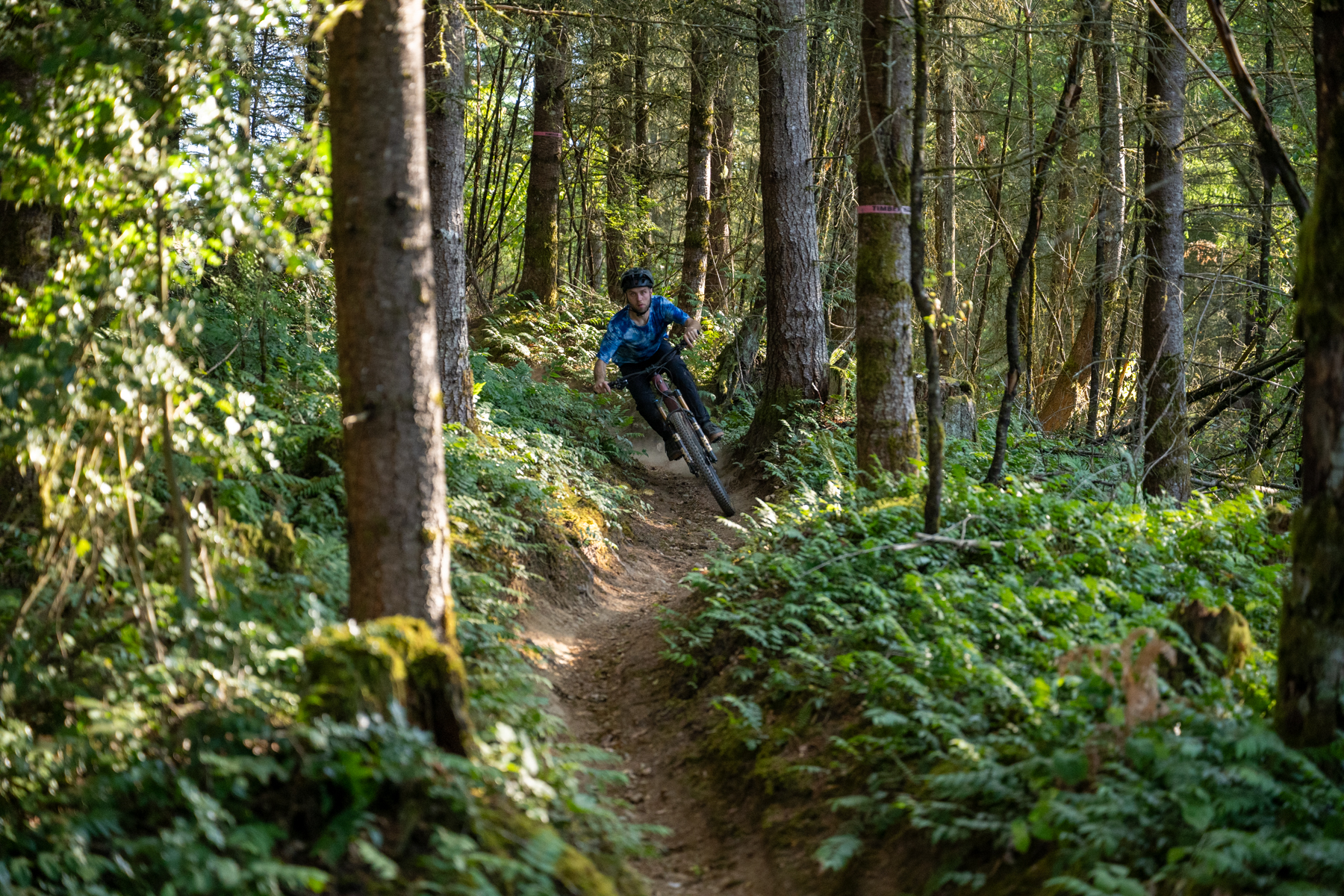
I’ll hold off on commenting further on the Hugene’s suspension performance on the way up, since I’m in full agreement with Zack on that part. I’ll just add that I spent some time experimenting with lighter wheels and faster rolling tires on the Hugene, with fairly predictable results. Lighter wheels (I mostly ran Enve M6s in that role) make the Hugene feel a bit snappier/accelerate quicker, as do faster rolling tires at the expense of some grip and composure on the way back down.
[To be clear, I chose the wheel and tire spec for our review bike, off a relatively limited menu of options that Propain had available a bit before the bike launched. If you want to blame anyone for putting an overkill wheel and tire combo on here, yell at me. In an ideal world, I would have put some lighter wheels on (DT XM 1700s would be a better fit, for example), but I was quite happy with the Continental Kryptotal tire selection.]
Long story short, the Hugene pedals reasonably well, and offers quite good traction under power for a 130mm-travel bike, but wouldn’t be my first recommendation if ultra-snappy pedaling performance is at the top of your priority list. The Hugene still feels sharper than most bikes with appreciably more suspension travel and grippier than most bikes that feel notably more efficient, so I think the balance it strikes is entirely reasonable. Particularly given how it feels on the way down.
Descending
Zack: Cutting right to the chase, I think the new Hugene is one of the more rewarding short-travel bikes I’ve ridden in terms of how comfortable and confident it feels at higher speeds, while remaining fun at slower ones too. At lower speeds and on flatter trails, the Hugene has good energy return from the suspension, making pulling for small gaps or snapping into corners a lot of fun. The frame feels laterally snappy, and while the long wheelbase and chainstays mean it’s not quite as eager to manual or change direction at lower speeds as some other bikes are, it’s still what I’d call a fun, energetic bike. I again think that lighter wheels and tires could liven things up further, but that would detract from what I’m about to say next.
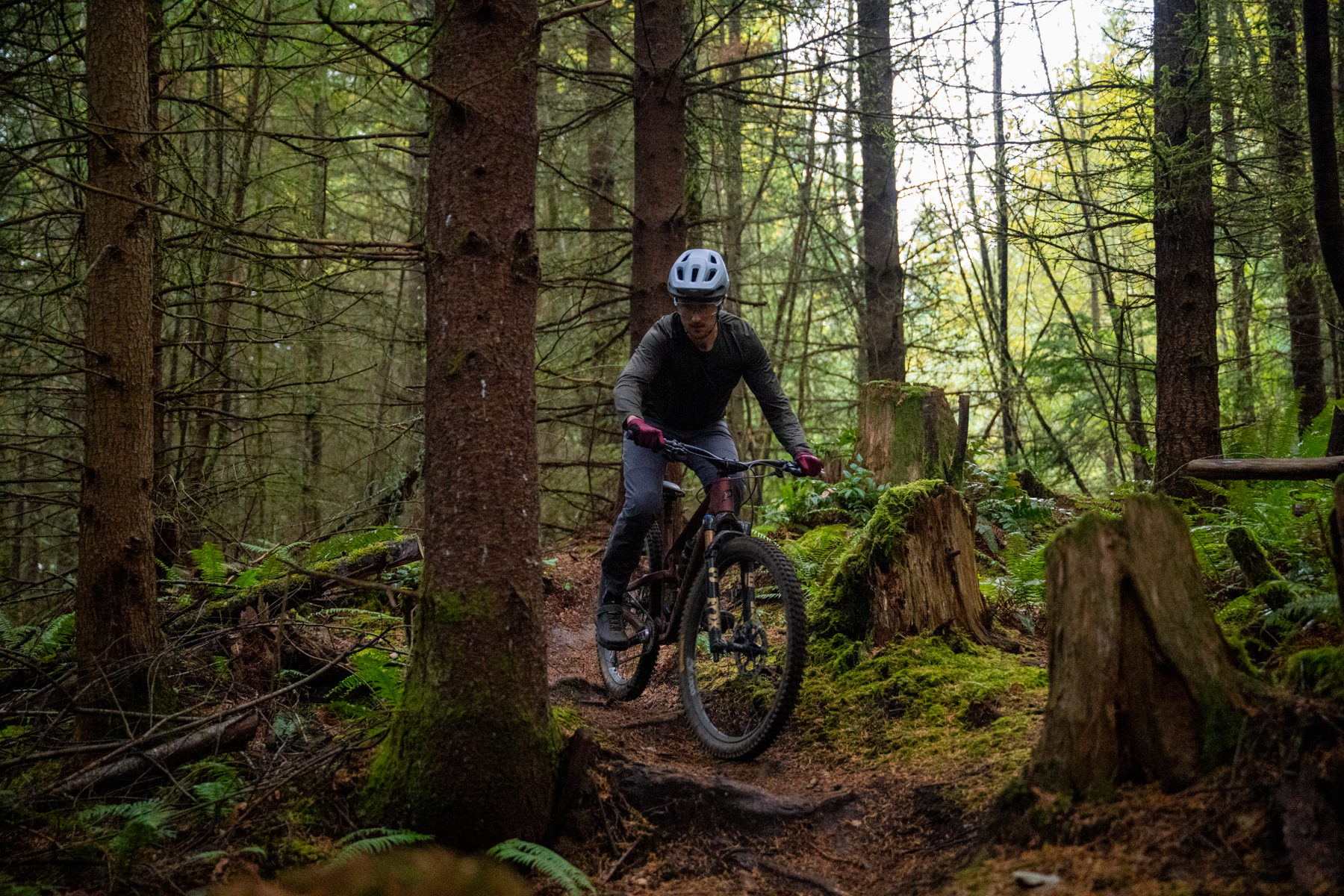
Where the Hugene really impresses me is in rougher, faster, and more consequential terrain. In these situations, the rear suspension feels excellent — it’s still taut and poppy, but manages to contour to the trail impressively well and make a lot of grip in return. Those longer chainstays start to bear fruit here, too, by allowing a very centered stance that lends a sense of calm to the Hugene’s ride quality, even in hairy situations. The frame also feels laterally stiff and substantial, which helps to keep things pointed in the right direction when ping-ponging between rocks or locking into a steep rut.
David: I’m maybe a little less high on how sharp the Hugene feels on slower, tighter trails than Zack is, but we’re in full agreement that it’s a blast once you get it up to a little bit of speed and start looking for stuff to boost off, pump through, and ride it actively. And to be clear, the bar for how fast you need to be going for the Hugene to come into its own is not very high. It can feel a little ponderous in the kind of tight, low-speed jank where bunny hopping more or less equates to a trials move, but once you’re moving enough to pump features, the Hugene comes alive quickly.
The Hugene works best when it’s ridden relatively actively and dynamically, rather than just pointing the bike and hanging on. It is more stable than average for a bike in its travel bracket, which can require more exaggerated body movements to boost and pump than some of its more compact competitors, but also affords a huge sweet spot in which to do so without throwing its balance off-kilter.
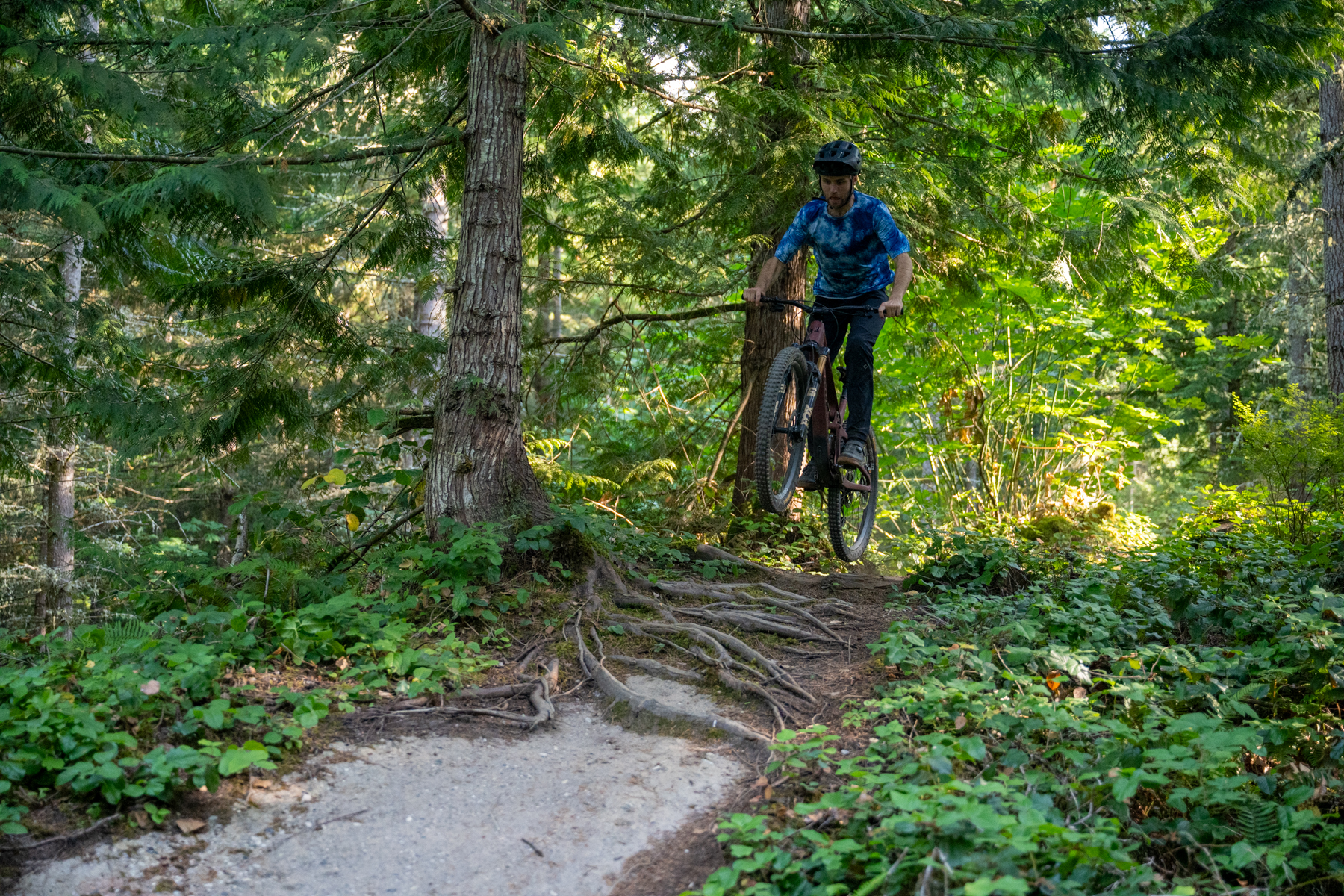
It’s easy to imagine that appealing to a lot of riders who spend a lot of time on bigger, more gravity-oriented bikes, and are interested in the Hugene as a sharper, more lively option for mellower trails and/or to spice up familiar ones. Compared to the general class of ~130mm-travel bikes, the Hugene works best with a more centered stance than average, and its preferred body positioning feels more reminiscent of a lot of Enduro bikes. But the Hugene still manages to be quite a bit quicker handling and more responsive than those, and feels coherent in doing so. Because:
Zack: The interesting thing about the Hugene is that it never feels like it has more travel than it does, in a good way. When compared to some bigger bikes that offer comparable levels of stability, the Hugene can still change direction a bit more quickly, and offers far more response and energy return when pressing into the suspension. So while the stable handling allowed me to get away with riding moves that I’d typically reserve for bikes in the 150 mm+ travel bracket, the suspension gave me the response and fun-factor that I’m looking for in a shorter travel bike, too.
I’ll go into this in more detail in our Deep Dive on the Hugene, but that’s a pretty big change from how I felt about the Hugene 2. I already mentioned the Hugene 2’s less-than-impressive small bump compliance, but that lack of compliance also could manifest as a lack of grip in some scenarios, almost as though the suspension weren’t tracking the ground as well as it could. The Hugene 2 also seemed more eager to blow through its travel, which has clearly been tweaked with the Hugene 3.
Perhaps the biggest factor, though, was the Hugene 2’s stability — while it was lots of fun on smoother trails, it definitely kept me on my toes as things got steeper and faster, with a much smaller safety net than I feel with the Hugene 3. The Hugene 2 also had an especially flexy rear end, which could start to feel like it was winding up and springing back when trying to hold a line through repeated impacts.
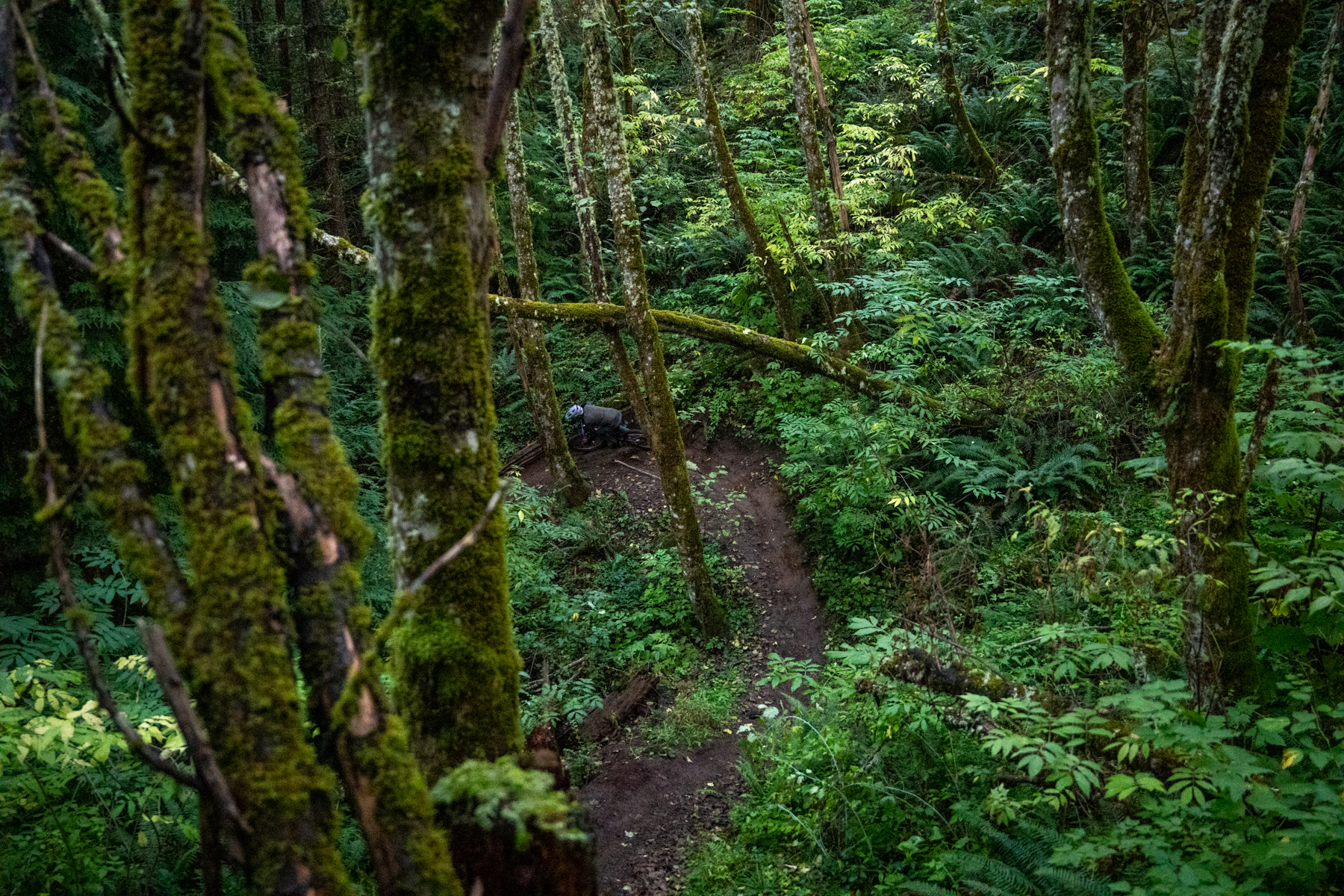
David: I want to reiterate Zack’s line that “the Hugene… never feels like it has more travel than it does, in a good way,” because it’s key to understanding what the Hugene does (and doesn’t do) best. The Hugene 3 is still a very lively, poppy bike, just one with a bit more stable handling than most bikes with similar suspension performance.
As Zack touched on, that handling makes the Hugene more confidence-inspiring and composed on steep, rough trails than a lot of bikes in its travel bracket, but it’s still no match for most longer travel All-Mountain (to say nothing of Enduro) bikes when things get really rowdy. Where the Hugene stands out most is on fast, flowy trails, where speeds are high enough for its comparatively stable handling to feel like an asset, but things aren’t so rough as to call for more suspension travel.
There, the lively nature of the Hugene really shines. Its suspension is quite poppy and energetic feeling (particularly once I added a much larger volume spacer to the rear shock), and the Hugene readily encourages you to pump through and boost off terrain features with abandon. Its relatively stable handling and large sweet spot for body positioning leave a sizeable margin for error if you don’t nail the landing when pulling for a natural gap in the trail, and while the Hugene takes somewhat more exaggerated body movements to flick around than some more compact bikes, it’s still very eager to get airborne once you’re up to a little bit of speed.
I don’t mean to imply that the Hugene feels like a dedicated flow trail bike or anything like that — it’s a pretty versatile all-rounder. But it is a bike that I especially clicked with on trails that leave it a bit of room to run, rather than being super tight and low-speed, and where things aren’t so rough that I found myself wanting a bunch more suspension travel. Plenty of raw, natural trails fit the bill there — we’re not just talking about machine-built jump lines — and, again, the bar for how fast the Hugene needs to be going to wake up isn’t super high. I think the more operative thing is that the Hugene is most likely to click for folks who (1) want to try to push the pace on descents a bit and (2) want a bike that rewards a fairly active, dynamic riding style over just trying to bulldoze through stuff.
The Build
Zack: I mentioned the build a few times above, and I think it’s a big part of why the Hugene 3 feels as grippy and stable as it does. Propain has a couple of starter builds, but otherwise offers an abundance of customization options, which our build took full advantage of. Between the 140 mm Fox 36 Factory Grip X2 fork, Float X shock, Magura MT7 brakes with 203 mm rotors, 35 mm rise OneUp V2 bars, DT Swiss EX1700 wheels, and Enduro-casing Continental Kryptotal tires, it was a solid and substantial build more akin to what you might expect on a bike with 20–30 mm more travel.

All of those parts performed as expected, which is to say, quite well. As much as the pad rattle and hard-to-cure rubbing of the MT7 brakes annoyed me at times, they felt snappy, consistent, and powerful throughout the test. The Fox 36 is a strong performer — I’m a huge fan of the Grip X2 damper for its improved support and feel over the (admittedly much lighter) Grip X damper, and the chassis feels well-selected for the Hugene’s ride quality. We’ll have more to say on the new 36 when we drop our upcoming review of both the 36 Grip X2 and lighter 36 SL, so be on the lookout for that.
This was also the first bike I’ve personally ridden with Shimano’s new XTR Di2 drivetrain. As a committed fan of Shimano’s mechanical groupsets, I was very pleased to find the fast, smooth shifting of those drivetrains to be on display here, too. The electronics help to take precision to the next level, and the accuracy of each shift was really impressive throughout the test. I also happen to love the shifter ergonomics, which feel…well, like a regular shifter (sorry, SRAM Pod Controller). Where it falls short for me, though, is in the excessive chain slap, which seems to stem from the switch to spring-based derailleur cage management from the clutch design of old. As frustrating as the high-maintenance clutches of Shimano’s mechanical groups can be, the new design feels like a slight step backward in terms of chain management.
While I openly acknowledge that our bike’s build may feel like overkill for some folks, I think it suited the Hugene’s personality quite well. Some lighter wheels and tires would definitely go some ways toward rounding out the Hugene’s personality in flatter terrain, but its geometry is inherently stable enough that I see the slightly beefier parts as playing well to the Hugene’s strengths.
David: I’ll keep this bit short — Zack covered things nicely. I’ll just add that Propain offers a wide array of build customization, should you want to do so. The build on our review bike is decidedly at the burly end of the spectrum for a 130mm-travel bike like the Hugene, but in a way that complements what the Hugene does best, rather than feeling wildly overkill. If you want to go for a lighter build, that’s certainly an option. That said, the array of parts in Propain’s online configurator skews to the burly side — they seem to be on the same page in thinking that it’s a bike that benefits from a relatively stout build.
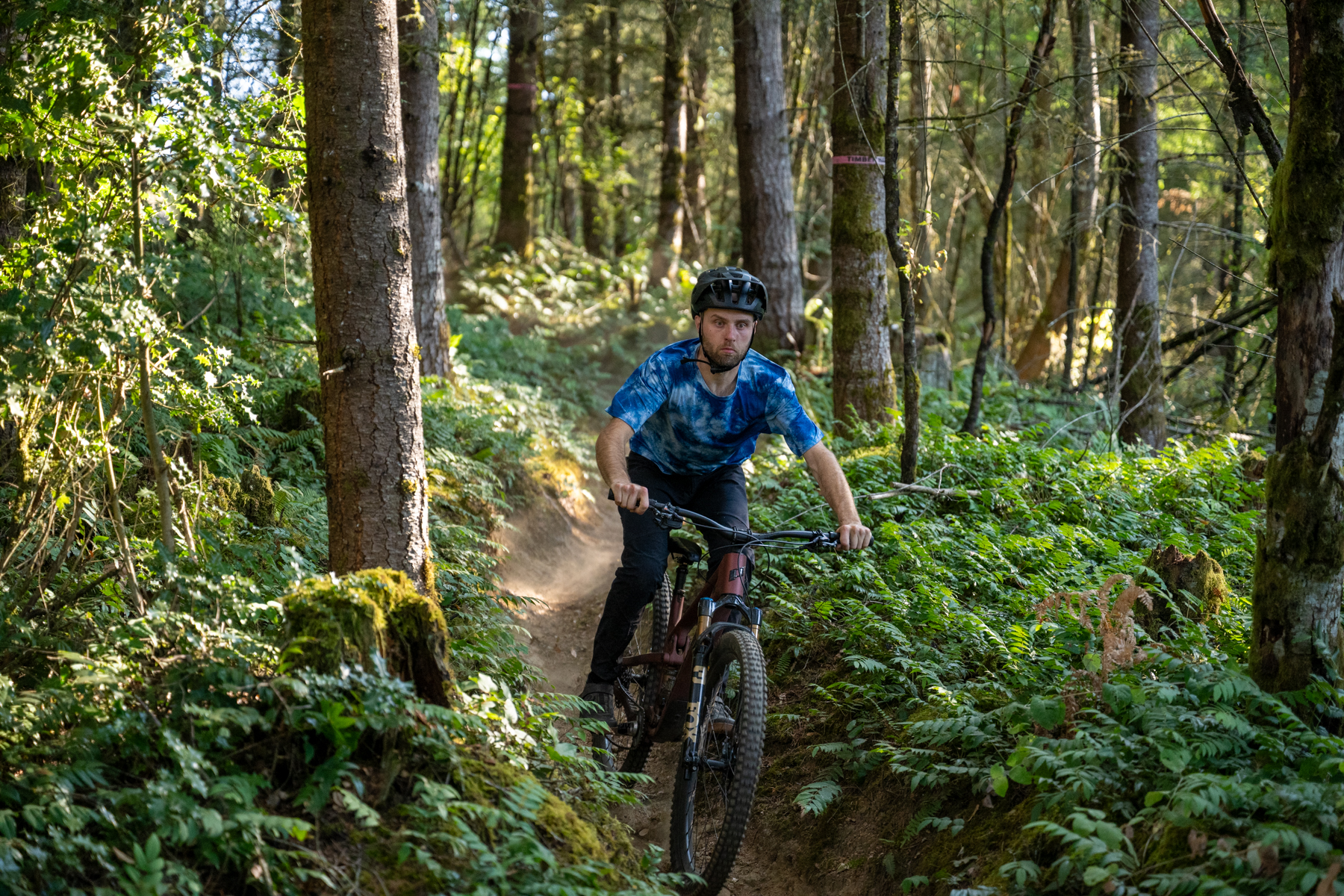
Who’s It For?
Zack: The Hugene 3 is an impressively versatile offering from Propain, and it has a far broader appeal than I initially expected. That said, I don’t think that appeal is for true XC riders — this is a bike that rides beyond what its travel figures suggest, and folks looking for lots of uphill performance should look at some of the more lithe, XC-focused bikes on the market.
Where the Hugene shines is in its ability to provide the responsive, playful ride that a lot of us look for in a short-travel Trail bike, with an extra boost of capability if you decide to push it into territory typically reserved for burlier bikes. In those situations, it feels surprisingly calm and composed, making it a great choice for someone who likes the idea of a shorter travel bike but doesn’t want to rein in their more aggressive descending style.
David: Zack and I are on the same page here. The Hugene 3 might work as the bigger bike in the quiver of an XC-focused rider who wants a relatively stable, composed bike that’s still more lively and responsive than most stuff with substantially more suspension travel. But I think its main appeal is for more aggressive, gravity-focused riders who want a sharp, lively Trail bike that feels more akin to a bigger gravity sled in its fit and preferred body positioning than most other bikes in its travel bracket.
The Hugene 3 does an uncommonly good job of blending fit and handling traits from a bit bigger bike with very lively, responsive suspension, while still feeling like a coherent package. Under an aggressive rider who wants to ride it actively and dynamically across a relatively wide range of terrain, that comes together nicely.
Bottom Line
The Hugene 3 may have less travel than the old one, but it has gained a whole lot of composure thanks to thoughtful updates to frame stiffness, suspension kinematics, and geometry. It strays from the efficiency-focused feel of the Hugene 2 and shouldn’t be the first choice for riders looking for an XC-derived ride, but it still delivers short-travel pep and response. Where the Hugene 3 really stands out is in how it combines a lively demeanor backed up by more game-on descending chops when called upon.
Deep Dive Comparisons
BLISTER+ members and those who purchase our Digital Access Pass can check out our Deep Dive comparisons linked below. Get our Digital Access Pass to view all our Deep Dives and Flash Reviews, or become a BLISTER+ member today to get access to that and a LOT more, including the best worldwide Outdoor Injury Insurance, exclusive deals and discounts on skis, personalized gear recommendations from us, and much more.
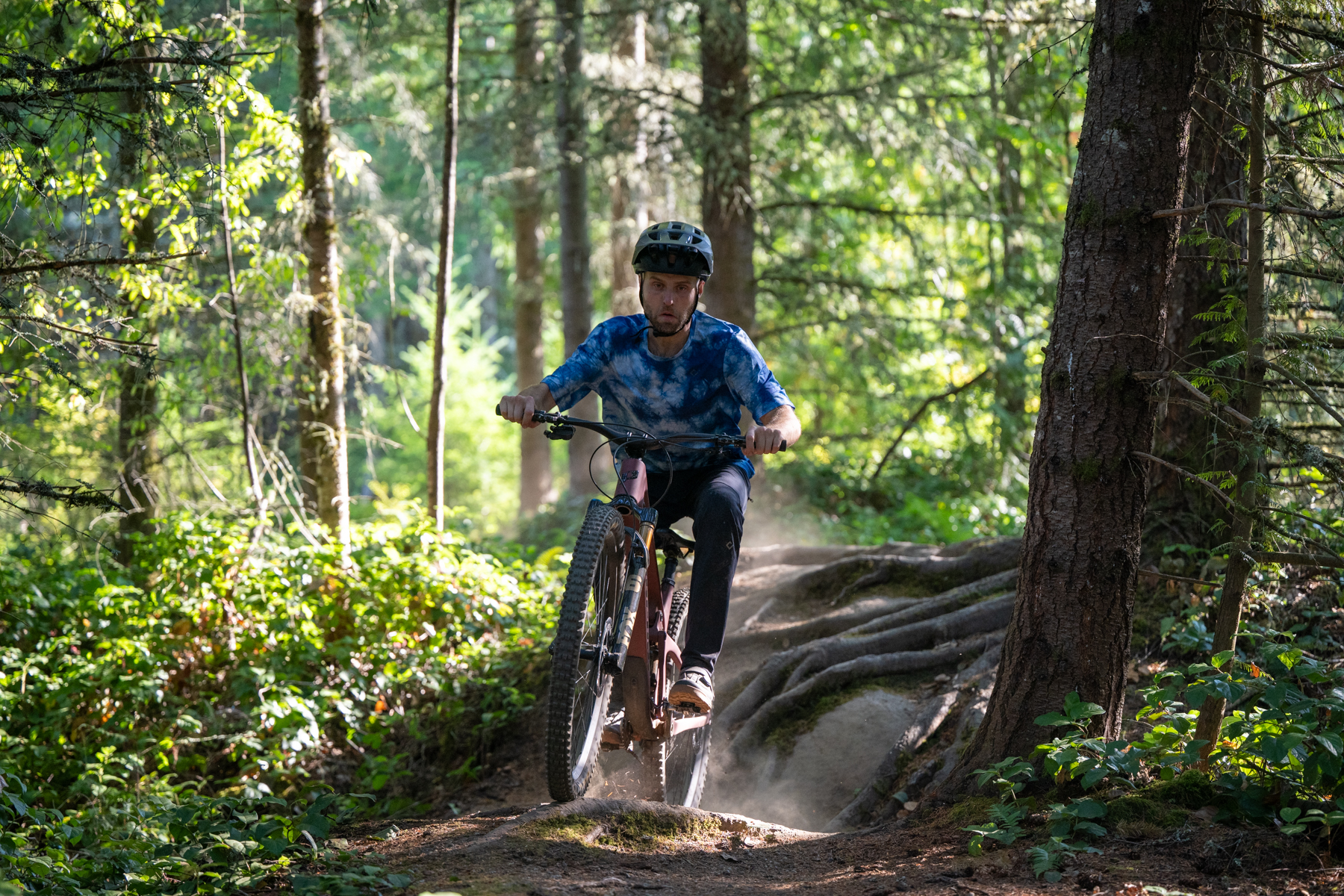
Deep Dive: Propain Hugene 3
We compare the Propain Hugene 3 CF to the Propain Hugene 2, Revel Rascal V2, Kona Process 134, Rocky Mountain Instinct, Trek Top Fuel, Transition Smuggler, Pivot Trailcat LT, Chromag Reazon, Canyon Spectral 125, Knolly Fugitive 140, Forbidden Druid, and Norco Optic.
Blister’s Flash Reviews and Deep Dives are accessible to those who purchase one of our paid subscriptions
To get our comprehensive Deep Dives and our initial, unfiltered reports on new gear, become a member and receive many other services, deals, and discounts.
If you’re already an active member, please log in.
(If you’re already logged in and a member in good standing and seeing this message in error, please refresh this page in your browser.)

Well, as we’re at the end of a heat wave, I’ve parsed this First Look more than usual, so apologies in advance:
“the new one has (slightly) more aggressive geometry than its predecessor” Picking nits, for sure, but I’d argue that the geo is more relaxed, not more aggressive.
“though, mercifully, there are ports in the downtube so that you can skip that option” Praise be unto the entity of your choice!
“The Hugene gets its 130 mm of rear wheel travel from a 210 x 47.5 mm shock” That seems like a pretty short-stroke shock for 130 mm travel (my Top Fuel uses 55 mm for 130 mm). Is that due to the compressing from both ends rear suspension design?
Fork: RockShox Lyrik Ultimate: An absolutely lovely fork, but on a 130/140 build, I’d probably argue that the Pike is more than adequate (and uses the same damper).
Thanks for reading!
On the “aggressive” geometry note, I think we’re actually saying the same thing — the new one is a little longer, slacker, and lower (i.e., more aggressive-descending-oriented).
Re: the Lyrik vs. Pike, you can build one with a Pike if you want — that’s the beauty of Propain’s custom configurator.
As for the shock stroke, it’s maybe a touch shorter than average for a 130 mm travel bike, but not by that much. A lot of 130 mm bikes use a 50 mm stroke one.
Almost seems like they’re planning a lunch ride version with more fork and a bit of extra stroke.